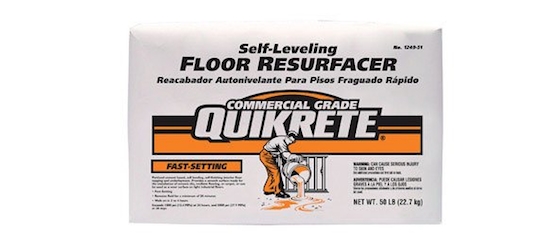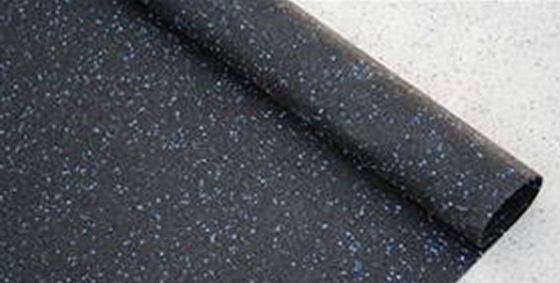How To Level a Floor
How To Level a Floor TIPS
- Flat doesn't mean level all the time
- Level foundations and wood i-beams make a level floor
- Self-leveling compounds great for old homes - SEE below
- Shingles work under hardwood flooring
- CLICK HERE to Get Tim's FREE & FUNNY Newsletter!
DEAR TIM: It's time for me to install some ceramic tile and hardwood flooring. I read on your website that it's really important for the subfloor to be flat and level if at all possible. Since I don't want the tile to crack and the hardwood to squeak, what are some great ways to achieve a nice, flat level floor? Are there special methods or tools one can use? Craig V., Evanston, IL
DEAR CRAIG: I found out the hard way what happens when you don't take the time to get a subfloor flat and level prior to covering it with either tile or hardwood.
Cracked Tile
Many years ago I was installing tile on a commercial restaurant job, and when the heavy cooking vessel was placed in the kitchen, the tile beneath each foot cracked. There were small low spots under these tiles, and the weight of the fixture pushed the tiles down causing them to crack. It was a nightmare to repair.
More Than Flat
Before we get started on your projects, let's first step back and discuss what your goals are and the difference between flat and level. You want crack-free tile and squeak-free hardwood. It's important to understand that just getting the floors flat, and possibly level, will not guarantee the results you're looking to achieve.
There are other things you need to do with both materials.
CLICK HERE to get FREE & FAST BIDS from local flooring contractors - the exact one you need!
Flat Doesn't Mean Level
There's a big difference between a floor that's flat and one that's level. You can have a flat floor where all points are in the same plane, but it's not level.
This is what you'll get in most houses as it's very rare that floors in most houses are truly level. A flat floor is like a smooth piece of glass or flat table top. You can tilt either of these and the surface is still flat, just not level.
Level Begins At Foundation
If you have a great builder and a fantastic foundation contractor, you can get really level floors. It's easiest to achieve this using engineered floor joists as they are extremely accurate and consistently the same size.
When these joists are installed on a foundation that's level, you get a level floor.
Old Home Woes
Older homes typically don't have level floors. But if you're remodeling and want flat floors, you can usually achieve this without too much trouble.
The trick is to establish a benchmark point that represents the highest point on the floor. It's easier to add shimming material than it is to grind off concrete or sand away wood.
Floor Leveling Compound
Imagine being able to mix up a magic batch of goo that was the consistency of runny pancake batter. You pour it on the floor, use a squeegee to move it around and walk away.
When you come back in a few hours, the floor is perfectly level. Yes, sounds crazy but it's true. CLICK HERE to order some of this magic material.

This is a powder you mix with water. You then pour it and it levels itself. It's magic. CLICK THE IMAGE NOW TO ORDER IT.
Long Straightedge
Many contractors use a 6-foot level or accurate straightedge to help them locate high and low spots in a subfloor. If you place one end of the level or straightedge on the benchmark high spot and slowly rotate the level around the floor, you'll discover both low and high spots.
A flashlight aimed at the bottom of the level or straightedge will help you quickly see low spots as the light passes under the level or straightedge.

This new dual-laser tool can help you level floors in minutes. It's highly accurate and rotates the laser beams in a full circle. Copyright 2017 Tim Carter
CLICK THIS IMAGE NOW TO ORDER THIS CRAZY TOOL. It really works! I've tested it myself.
Fancy Tools
A brand new electronic tool can help you discover low and high spots in a floor using intersecting laser beams. This tool projects out two laser beams that create a three-dimensional letter X. CLICK HERE to read all the specifications about this laser tool.
You set up the tool on the benchmark high spot you're trying to recreate all over the floor. The center of the X created by the two lasers lines is projected across the floor.
CLICK HERE to get FREE & FAST BIDS from local flooring contractors - the exact one you need!
Laser Math
Where you see just one laser line on the surface of the floor, this means that area is the same elevation as the benchmark. If you see two parallel laser lines on the floor, that is telling you that spot is higher or lower than the benchmark location. You use a small target board that comes with the tool to tell you if the spot is higher and lower and by how much. It's an ingenious tool.
Rotates 360°
This electronic tool also rotates in a circle so you can set it up on one spot and start to mark out on the floor all of the high and low spots by yourself. A handy remote control allows you to adjust the speed of the rotating tool or completely stop it as you make adjustment marks on the floor.
Strong Filler
It's important for you to add strong material at the low spots so that your finish flooring will not bend under pressure. Fine sand mixed with Portland cement works well to help build up low spots on concrete floors that are 1/8-inch or deeper.
Wall grout that has no sand works fine for shallower depressions.
Asphalt shingles work really well to fill low spots in wood floors when you're installing 3/4-inch traditional hardwood flooring that will be nailed to the wood subfloor.
Screw Subflooring
Before you start to level a wood subfloor, make sure the subflooring is attached well to the floor joists. Use screws to fasten the subfloor to the joists.
Severe cracks in concrete slabs need to be filled with concrete epoxy to ensure the slab doesn't continue to crack and separate.
Crack Isolation Matts
Be sure to use crack-isolation materials between the tile and concrete slabs. You want the tile assembly to be independent of the concrete slab to minimize future cracks in the tile.
You can watch a video discussing installing tile on wood floors. Simply type "ceramic tile on wood floor video" into the search engine here at www.AsktheBuilder.com.
CLICK HERE to get FREE & FAST BIDS from local flooring contractors - the exact one you need!
Column 940

2 Responses to How To Level a Floor